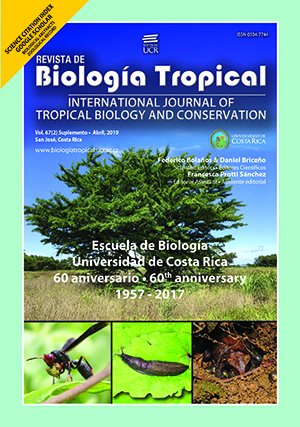Abstract
Tick-borne rickettsiosis is becoming a common emergent disease in many tropical countries, and the rapid detection of this disease could reduce the impact on wild life and public health. Pools of larvae and nymphs, and individual adult ticks are used for detection of Rickettsia species (Rickettsiaceae), but the number of larvae and nymphs in the pools likely affect the probability of detection of Rickettsia spp. We tested whether the number of larvae or nymphs of Amblyomma (Ixodidae) included in the pools affected the probability of detection. The number of larvae in each pool did not affect the probability of detecting Rickettsia spp., but the probability of detection increased rapidly with the number of nymphs. In this study, 20 nymphs are enough to approach a probability of 1 of detecting Rickettsia
References
Hall, T. A. (1999). BioEdit: a user-friendly biological sequence alignment editor and analysis program for Windows 95/98/NT. Nucleic Acids Symposium Series, 41, 95-98.
Hartshorn, G. S. (1983). Plants: introduction. In D. H. Janzen (Ed.), Costa Rican Natural History (p. 118-157). Illinois: University of Chicago Press.
Labruna, M. B., Ogrzewalska, M., Soares, J. F., Martins, T. F., Soares, H. S., Moraes-Filho, J., ... Pinter, A. (2011). Experimental infection of Amblyomma aureolatum ticks with Rickettsia rickettsii. Emerging Infectious Diseases, 17, 829-834.
Labruna, M. B., Whitworth, T., Horta, M., Bouyer, D., McBride, J., Pinter, A., …Walker, D. (2004). Rickettsia species infecting Amblyomma cooperi ticks from an area in the state of São Paulo, Brazil, where Brazilian Spotted Fever is endemic. Journal of Clinical Microbiology, 42, 90-98.
Lopes, M. G., Junior, J. M., Foster, R. J., Harmsen, B. J., Sanchez, E., Thiago F. Martins, T. F., … Labruna, B. (2016). Ticks and rickettsiae from wildlife in Belize, Central America. Parasites & Vectors 9, 62. DOI: 10.1186/s13071-016-1348-1.
Martins, T. F., & Labruna, M. B. (2015). Bacteria of the genus Rickettsia in ticks (Acari: Ixodidae) collected from birds in Costa Rica. Ticks and Tick-borne Diseases, 6, 478-82.
Mata, A., & Echeverría, J. (2004). Introduction. In G. W. Frankie, A. Mata, & S. B. Vinson (Eds.), Biodiversity conservation in Costa Rica (pp. 1-12). Berkeley: University of California Press.
Mörner, T., Obendorf, D. L., Artois, M., & Woodford, M. H. (2002). Surveillance and monitoring of wildlife diseases. Scientific and Technical Review of the Office International des Epizooties, 21, 67-76.
Nicholson, W. I., Sonenshine, D. E., Lane, R. S., & Vilenberg, G. (2009). Ticks (Ixodida). In G. R., Mullen & L. A. Durden (Eds.), Medical and Veterinary Entomology (pp. 483-532). Massachusetts: Academic Press.
Oliver, J. H. Jr. (1989). Biology and systematics of ticks (Acari: Ixodida). Annual Review in Ecology and Systematics, 20, 397-430.
Oorebeek, M., & Kleindorfer, S. (2008). Climate or host availability: what determines the seasonal abundance of ticks? Parasitology Research, 103, 871-875.
Parola, P., Paddock, C. D., Socolovschi, C., Labruna, M. B., Mediannikov, O., Kernif, T., … Raoult, D. (2013). Update on tick-borne rickettsioses around the world: a geographic approach. Clinical Microbiology Reviews, 4, 657-702.
R Development Core Team. (2014). R: A language and environment for statistical computing. R Foundation for Statistical Computing. Vienna, Austria: R Core Team.
Roux, V., Rydkina, E., Eremeeva, M., & Raoult, D. (1997). Citrate synthase gene comparison, a new tool for phylogenetic analysis and its application for the rickettsiae. International Journal of Systematic Bacteriology, 47, 252-261.
Santibáñez, S., Portillo, A., Santibáñez, P., Palomar, A. M., & Oteo, J. A. (2013). Usefulness of rickettsial PCR assays for the molecular diagnosis of human rickettsioses. Enfermedades Infecciosas y Microbiología Clínica, 31, 283-288.
Saraiva, D. G., Nieri-Bastos, F. A., Horta, M. C., Soares, H. S., Nicola, P. A., Pereira, L. C., & Labruna, M. B. (2013). Rickettsia amblyommii infecting Amblyomma auricularium ticks in Pernambuco, northeastern Brazil: isolation, transovarial transmission, and transstadial perpetuation. Vector Borne Zoonotic Diseases, 13, 615-618.
Soares, H. S., Barbieri, A. R., Martins, T. F., Minervino A. H., de Lima, J. T., Marcili A., … Labruna, M. B. (2015). Ticks and rickettsial infection in the wildlife of two regions of the Brazilian Amazon. Experimental and Applied Acarology, 65, 125-140.
Troyo, A., Moreira-Soto, R. D., Calderón-Arguedas, O., Mata-Somarribas, C., Ortiz-Telloa, J., Barbieri, A. R. M., … Taylor, L. (2016). Detection of rickettsiae in fleas and ticks from areas of Costa Rica with history of spotted fever group rickettsioses. Ticks and Tick-borne Diseases, 7(6), 1128-1134.
Vargas, M., 2006. Clave para los géneros más comunes de larvas de Ixodida (Acari: Ixodidae). Agronomía Costarricense, 30, 101-106.
##plugins.facebook.comentarios##

This work is licensed under a Creative Commons Attribution 4.0 International License.
Copyright (c) 2019 Revista de Biología Tropical






